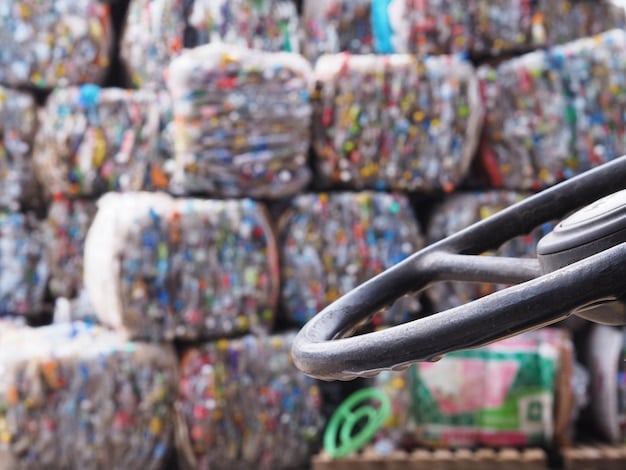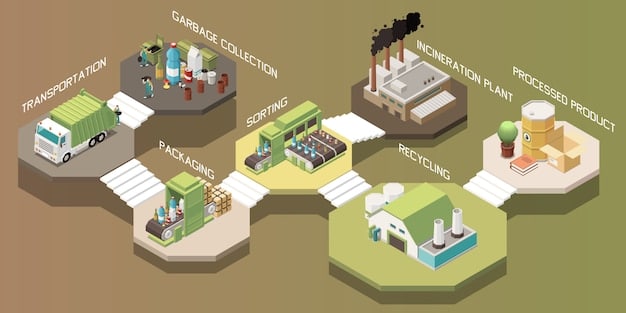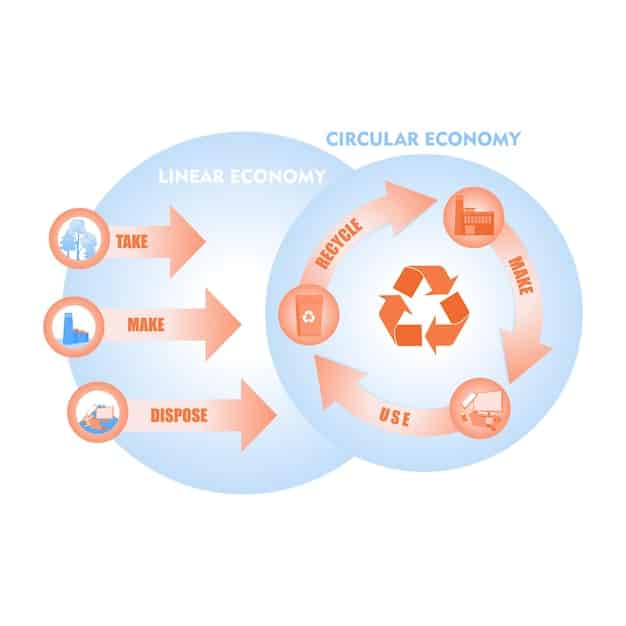The Truth About Recycling: Are Current Efforts Making a Difference?

While recycling efforts have expanded significantly, their true impact on environmental sustainability remains a complex issue influenced by economic viability, policy inconsistencies, and global market dynamics.
In our increasingly eco-conscious world, the mantra of “reduce, reuse, recycle” has become a familiar call to action. But as we diligently sort our plastics, papers, and glass, a pressing question emerges: The Truth About Recycling: Are Current Efforts Actually Making a Difference? This inquiry delves beyond the simple act of tossing a bottle into a blue bin, exploring the intricate global systems, economic realities, and environmental impacts that truly define the success—or shortcomings—of our recycling endeavors.
The recycling dilemma: a global perspective
The concept of recycling, at its core, is elegantly simple: transform waste materials into new products to prevent the consumption of fresh raw materials. This process aims to reduce pollution, conserve natural resources, and decrease landfill waste. However, the practical application of recycling across the globe introduces a myriad of complexities, revealing a system far from perfect and often fraught with challenges.
Historically, recycling gained significant traction in the latter half of the 20th century, spurred by growing environmental awareness and concerns over resource depletion. Nations adopted varying approaches, from curbside collection programs to specialized processing facilities. Yet, the initial enthusiasm often overlooked the intricate economic and logistical frameworks required for genuinely effective recycling. Many early systems were designed with good intentions but lacked the robust infrastructure and market demand necessary to sustain themselves.
The global landscape of waste management
Different countries exhibit vastly different recycling rates and capabilities. European nations, particularly Germany and Austria, lead the way with high recycling and composting rates, largely due to stringent regulations, advanced sorting technologies, and strong producer responsibility schemes. In contrast, many developing nations struggle with basic waste collection, let alone sophisticated recycling, often resorting to open dumping or incineration. Even within developed countries, significant disparities exist between regions and municipalities, reflecting varied investments in infrastructure and public engagement.
- Policy inconsistencies: Lack of standardized recycling policies across states and nations creates confusion and inefficiencies.
- Infrastructure disparity: Wealthier regions typically have more advanced recycling facilities than less affluent ones.
- Market volatilities: The demand and price for recycled materials fluctuate, impacting the economic viability of recycling programs.
- Technological limitations: Not all materials are easily or economically recyclable with current technologies.
The “China Sword” policy, enacted in 2018, served as a potent wake-up call to many Western nations, particularly the United States. For decades, China had been the primary destination for the world’s scrap plastic and paper. When China restricted imports of most recycled materials, citing contamination issues, it exposed the fragility of a system heavily reliant on exporting waste. This policy shift forced many countries to confront their own domestic recycling limitations, leading to stockpiles of unrecyclable materials, increased landfilling, and a scramble to develop local processing capacities.
Ultimately, a global perspective on recycling reveals a fragmented, inconsistent, and often economically challenging landscape. While the intent remains noble, the execution is a complex weave of policy, economics, technology, and geopolitical dynamics, all of which significantly influence whether current efforts truly make a difference.
Unpacking the economics of recycling
At the heart of why recycling often falls short of its potential lies a fundamental economic challenge. Unlike a simple production line where raw materials are consistently fed into a process, the economics of recycling are highly volatile and inherently complex. The industry operates within a global market where the value of recycled commodities can fluctuate dramatically, directly impacting the profitability and sustainability of recycling programs.
The economic viability of recycling is often dictated by two primary factors: the cost of collection and processing, and the market price for recycled materials. Collecting, sortin,g and cleaning materials are labor-intensive and energy-consuming processes. Advanced sorting technologies, while improving efficiency, also represent significant capital investments. When the costs of these operations exceed the revenue generated from selling the processed materials, recycling becomes economically unfeasible, leading to programs being cut or materials being diverted to landfills.
Supply, demand, and material value
The market for recycled materials is a classic case of supply and demand. When demand for recycled plastic, paper, or metal is high, prices increase, making recycling more attractive. Conversely, an oversupply of materials or a decrease in demand can cause prices to plummet. This volatility is exacerbated by global economic trends, energy prices (which affect transportation and processing costs), and the availability of virgin materials. For instance, when oil prices are low, producing new plastic from crude oil can be cheaper than processing recycled plastic, undermining the economic incentive for recycling.
- Plastic’s complex reality: Only certain types of plastics are economically viable to recycle; others, like thin films or mixed plastics, often end up in landfills.
- Paper’s price swings: The market for recycled paper is generally stable but can be affected by changes in printing and packaging industries.
- Metal’s robust market: Aluminum and steel are highly valuable and efficiently recyclable, often forming the profitable backbone of recycling operations.

Despite these challenges, innovative economic models are emerging. Some municipalities and private companies are exploring “circular economy” approaches, where products are designed for durability and ease of recycling, and manufacturers take greater responsibility for the end-of-life management of their goods. This shifts the focus from simple waste management to resource循环 and value retention, potentially stabilizing markets for recycled materials.
The economic landscape of recycling is not static; it is a dynamic interplay of costs, market forces, and policy incentives. Understanding these economic underpinnings is crucial to grasping why current recycling efforts, despite their environmental intentions, face significant hurdles in achieving widespread, sustainable impact.
The environmental footprint: more than just trash
When we talk about the environment and recycling, our minds often jump immediately to landfills and reduced waste. While these are critical components, the environmental footprint of recycling is far more nuanced, encompassing energy consumption, emissions, and the conservation of natural resources. Understanding this broader picture is essential to evaluating whether current recycling efforts truly make a positive difference.
The primary environmental benefit of recycling lies in reducing the need for virgin raw materials. For example, producing aluminum from recycled cans requires significantly less energy—up to 95% less—than producing it from bauxite ore. Similarly, recycled paper manufacturing uses less water and energy and produces fewer air pollutants than making paper from virgin pulp. This conservation extends to forests, minerals, and fossil fuels, thereby mitigating the environmental degradation associated with extracting and processing new resources.
Energy savings and emissions reduction
The energy saved through recycling translates directly into reduced greenhouse gas emissions. Fewer fossil fuels are burned for extraction, processing, and manufacturing, which helps to combat climate change. However, it’s crucial to acknowledge that recycling is not energy-free. Collection, transportation, sorting, and reprocessing all consume energy, often from non-renewable sources. The environmental benefit is therefore a net gain, achieved when the energy saved in manufacturing new products from recycled content outweighs the energy consumed in the recycling process itself.
- Transportation emissions: The distance materials travel from collection to processing facilities can contribute to carbon emissions.
- Processing energy: Cleaning, melting, and reforming recycled materials require substantial energy inputs.
- Contamination issues: Contaminated batches often lead to materials being landfilled, negating the environmental effort involved in their initial collection.
Beyond energy and emissions, recycling also plays a vital role in reducing pollution. Manufacturing with recycled materials typically generates less water pollution and air pollution compared to using virgin resources. It also reduces the need for landfill space, thereby decreasing methane emissions from decomposing organic waste and protecting habitats that might otherwise be used for landfills.
While the environmental benefits of recycling are demonstrable, they are not without their own environmental costs. The challenge lies in optimizing the recycling process to maximize net environmental gains. This involves investing in closer processing facilities, improving sorting technologies to reduce contamination, and ensuring that the demand for recycled content is robust enough to justify the entire recycling chain. Only then can we truly capitalize on recycling’s potential to lighten our environmental footprint.
Policy pitfalls and the path forward
The effectiveness of recycling efforts is deeply intertwined with the policies that govern them. From local municipal ordinances to national and international regulations, the framework of laws and incentives plays a pivotal role in shaping how materials are collected, processed, and reintroduced into the economy. Unfortunately, inconsistencies and design flaws in these policies often present significant pitfalls, hindering the true potential of recycling.
One of the most prominent policy pitfalls is the lack of standardization. In the United States, for example, recycling rules can vary wildly from one city to another, or even between neighborhoods. This patchwork of regulations — what’s accepted in one bin may not be in another — leads to widespread confusion among consumers and contamination of recycling streams. When non-recyclable items enter the system, they can clog machinery, reduce the quality of recyclable materials, and ultimately send entire batches to landfills.
Extended producer responsibility (EPR) as a solution
A promising policy approach gaining traction globally is Extended Producer Responsibility (EPR). EPR schemes shift the financial and physical responsibility for managing the end-of-life of products from municipalities and taxpayers to the producers themselves. This encourages manufacturers to design products that are durable, reusable, and easily recyclable, as they bear the cost of recycling or disposal. Countries like Germany and Canada have implemented successful EPR programs, leading to higher recycling rates and better material quality.
- Incentivizing design: EPR motivates companies to create products with recycling in mind, reducing waste at the source.
- Funding infrastructure: Producer fees under EPR can fund advancements in recycling infrastructure and technology.
- Global adoption: While still not universally adopted, EPR is seen as a key policy lever for a more circular economy.

Beyond EPR, other policy interventions include mandates for recycled content in new products, tax incentives for companies using recycled materials, and public education campaigns to improve consumer understanding and participation. Governments also have a role in investing in domestic recycling infrastructure, reducing reliance on volatile international markets for waste processing.
However, implementing effective policies requires strong political will and sustained investment. Lobbying by industries reliant on virgin materials can oppose stricter recycling mandates, and upfront costs for new infrastructure can be prohibitive. The path forward involves a collaborative effort between governments, industries, and consumers to create a robust and harmonized policy environment that supports an efficient and impactful recycling system, moving beyond the current fragmented approach.
Innovation and future prospects: beyond the bin
While current recycling efforts face significant challenges, the landscape of waste management is far from static. A wave of innovation is emerging, pushing the boundaries of what’s possible and offering encouraging prospects for a more effective and sustainable future. These advancements go “beyond the bin,” redefining how we approach materials, design products, and process waste.
One key area of innovation lies in advanced sorting technologies. Traditional recycling facilities often rely on manual labor or rudimentary optical sorters. The next generation of facilities is incorporating artificial intelligence (AI), robotics, and molecular sorting technologies. AI-powered robots can identify and separate different types of plastics or materials with unprecedented accuracy, significantly reducing contamination rates and increasing the purity of recycled streams. This precision makes recycled materials more valuable and desirable for manufacturers.
Chemical recycling and pyrolysis
For plastics that are difficult or impossible to mechanically recycle (e.g., mixed plastics, multi-layer packaging), chemical recycling methods are gaining attention. Processes like pyrolysis break down plastic waste into its fundamental chemical components, which can then be used to create new plastics or other chemicals. This approach offers the potential to recycle materials that previously had no viable end-of-life solution, expanding the range of recyclables and closing the loop for complex plastic waste. While still in nascent stages, with debates around scalability and environmental impact, chemical recycling presents a fascinating prospect.
- Advanced optics and AI: Improve material identification and separation, reducing human error.
- Molecular reprocessing: Technologies that break down materials to their chemical building blocks for new products.
- Decentralized recycling: Smaller, local recycling hubs using compact, efficient technologies.
- Smart bins: IoT-enabled bins providing data on waste composition and fill levels, optimizing collection routes.
Beyond technological innovation, there’s a growing emphasis on product design for circularity. This involves designing products from the outset to be easily disassembled, repaired, reused, and ultimately recycled. Companies are exploring new material composites that are inherently recyclable or biodegradable, and packaging is being redesigned to minimize material use and maximize recyclability. This upstream approach addresses the root cause of waste by creating products that fit seamlessly into a circular economy model, rather than just treating waste as an end-of-pipe problem.
The future of recycling is likely to be a combination of these advancements: smarter sorting, novel processing techniques for hard-to-recycle materials, and a fundamental shift in how products are designed and consumed. While challenges remain, these innovations offer a beacon of hope that our collective efforts can indeed make a substantial and lasting difference, transitioning us towards a world where waste becomes a resource, not a burden.
Consumer behavior and the human element
At the center of any recycling system, no matter how advanced, is the individual consumer. Our daily habits, understanding, and willingness to participate play a crucial role in determining the success or failure of recycling efforts. While policies and technologies provide the framework, the human element is the engine that drives the process, often dictating how much material is collected and how clean those streams are.
One of the biggest challenges related to consumer behavior is “wishcycling,” the act of putting non-recyclable items into the recycling bin with the hope that they might be recyclable. This well-intentioned but misguided practice is a major source of contamination. When recycling streams are highly contaminated, the processing costs skyrocket, and entire batches—sometimes many tons—can be rejected by recycling facilities and sent to landfills instead. This undermines the entire effort and economic viability of recycling programs.
The role of education and incentives
Effective public education is paramount. Many consumers genuinely want to recycle correctly but are confused by inconsistent labeling on products or by varying local rules. Clear, consistent, and easily accessible information about what materials are accepted and how they should be prepared (e.g., rinsing containers) can significantly improve participation rates and reduce contamination. Digital tools, such as mobile apps that clarify recycling rules based on location, are also emerging as valuable resources.
- Clear communication: Consistent labeling and local guidelines are vital for reducing confusion.
- Incentive programs: Deposit-refund systems for bottles and cans have proven highly effective in boosting recycling rates.
- Behavioral nudges: Simple cues and reminders can encourage correct recycling habits in public spaces and homes.
Beyond understanding, convenience also heavily influences consumer participation. Curbside collection programs, for instance, typically yield much higher recycling rates than drop-off centers, simply because they remove barriers to participation. The easier it is for people to recycle correctly, the more likely they are to do so consistently.
Cultivating a culture of responsible consumption and waste management also extends beyond just recycling. It involves encouraging consumers to reduce their overall consumption, choose products with minimal packaging, reuse items whenever possible, and compost organic waste. These upstream actions collectively lessen the burden on recycling systems and contribute more broadly to environmental sustainability. Ultimately, while systems and policies are critical, unlocking the full potential of recycling requires an engaged, informed, and proactive consumer base.
Recycling’s impact on communities and society
The implications of recycling extend far beyond environmental metrics and economic spreadsheets; they deeply influence communities and societal well-being. A robust recycling infrastructure can foster local jobs, promote civic engagement, and contribute to a more sustainable and resilient local economy. Conversely, ineffective or absent recycling programs can lead to significant social and public health issues.
One of the most immediate impacts is job creation. Recycling industries, from collection and sorting to processing and manufacturing new products from recycled content, generate a diverse range of employment opportunities. These jobs are often local, providing stable livelihoods within communities. The growth of a circular economy, driven by increased recycling and reuse, promises even greater job creation potential as businesses pivot towards sustainable production models.
Public health and civic engagement
Effective recycling programs also contribute to public health. By diverting waste from landfills and incinerators, recycling reduces air and water pollution, which can have direct positive effects on community health. Fewer landfills mean less potential for leachate contamination of groundwater and reduced methane emissions. For communities living near landfills, this can mean cleaner air and reduced exposure to harmful substances.
- Local economic growth: Recycling can support local businesses and create new jobs.
- Cleaner neighborhoods: Reduced litter and improved waste management enhance community aesthetics.
- Resource independence: Local recycling reduces reliance on foreign raw materials and encourages domestic resource management.
Moreover, recycling programs can foster a sense of civic responsibility and community cohesion. When residents actively participate in recycling, it strengthens their connection to environmental stewardship and collective action. Public clean-up efforts and educational initiatives around recycling often bring people together, reinforcing community bonds and shared values related to sustainability.
However, the social benefits are not uniformly distributed. Communities with limited resources or those that become host sites for recycling facilities or landfills can disproportionately bear the environmental burdens of waste management. Ensuring equitable access to effective recycling programs and addressing environmental justice concerns are critical aspects of building truly sustainable and healthy communities. The societal impact of recycling underscores its importance not just as an environmental strategy, but as a component of community development and social resilience.
| Key Point | Brief Description |
|---|---|
| 💰 Economic Viability | Recycling success hinges on fluctuating market prices for materials and the cost-effectiveness of processing. |
| 🌱 Environmental Footprint | Recycling reduces energy use and pollution, but its own processes also consume energy and produce emissions. |
| 📜 Policy & Infrastructure | Inconsistent policies and inadequate infrastructure often hinder recycling effectiveness. |
| 🤖 Innovation & Future | New technologies like AI sorting and chemical recycling offer promising solutions for hard-to-recycle materials. |
Frequently asked questions
▼
Yes, recycling significantly saves energy compared to producing new products from virgin materials. For example, recycling aluminum uses about 95% less energy than making it from raw ore. While recycling processes themselves consume energy, the net energy savings are substantial, contributing to reduced greenhouse gas emissions and a smaller carbon footprint.
▼
Many plastics are not economically recyclable due to their chemical composition, contamination, or mixed-material construction. Thin films, plastic bags, and certain types of food packaging are often difficult to sort and process profitably with current mechanical recycling technologies. This leads to them being diverted to landfills or incineration, despite public perception.
▼
“Wishcycling” is when people place non-recyclable items into recycling bins, hoping they will be recycled. This practice leads to contamination, increasing processing costs and the likelihood that entire batches of otherwise recyclable materials are diverted to landfills. It’s crucial for consumers to understand local recycling guidelines to avoid this.
▼
EPR policies shift the financial and physical responsibility for managing products’ end-of-life from consumers and municipalities to manufacturers. This incentivizes companies to design products that are more durable, repairable, and easily recyclable, leading to higher quality recycled materials and more sustainable production cycles, boosting actual recycling rates.
▼
Consumers are central to effective recycling. Their role includes understanding and following local recycling guidelines, reducing overall consumption, reusing items whenever possible, and supporting products made with recycled content. Correct sorting and preparation of materials significantly reduce contamination, making the entire recycling process more efficient and impactful.
Conclusion
The journey to understand whether current recycling efforts are truly making a difference reveals a complex narrative, far removed from the simple act of sorting waste. It’s clear that while the intentions behind recycling are noble and its potential benefits significant, the reality is
paved with economic hurdles, technological limitations, and policy inconsistencies. Yet, the story doesn’t end there; innovation in sorting, advances in chemical recycling, and the growing adoption of producer responsibility schemes point towards a more efficient and impactful future. Ultimately, the effectiveness of recycling hinges on a collective evolution: from individual consumer behavior to global policy and industrial design, each playing a vital role in transforming our waste into a valuable resource and truly closing the loop on a sustainable future.





